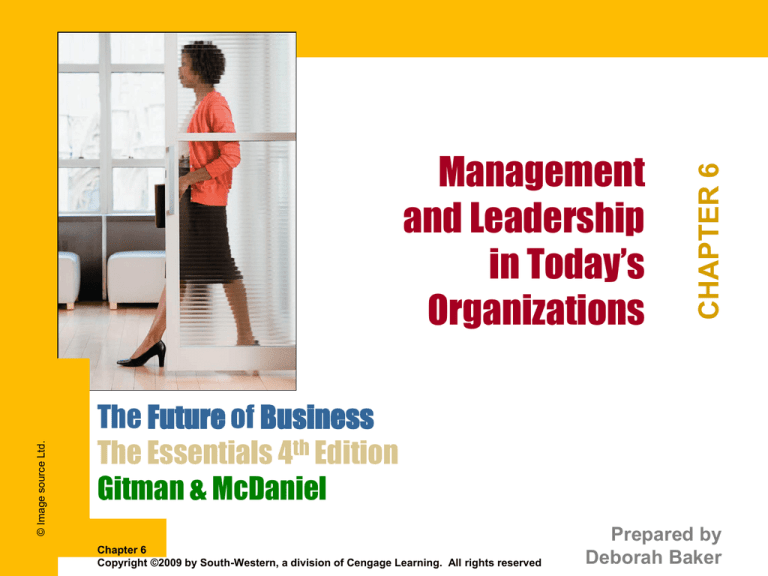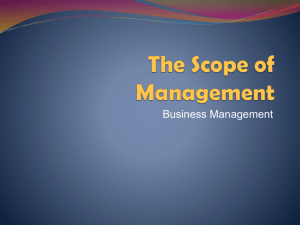
© Image source Ltd.
CHAPTER 6
Management
and Leadership
in Today’s
Organizations
The Future of Business
The Essentials 4th Edition
Gitman & McDaniel
Chapter 6
Copyright ©2009 by South-Western, a division of Cengage Learning. All rights reserved
Prepared by
Deborah Baker
CHAPTER 6
Learning Goals
1 What is the role of management?
2 What are the four types of planning?
3 What are the primary functions of managers
in organizing activities?
4 How do leadership styles influence a corporate
culture?
2
CHAPTER 6
Learning Goals (continued)
5 How do organizations control activities?
6 What roles do managers take on in different
organizational settings?
7 What set of managerial skills is necessary for
managerial success?
8 What trends will affect management in the future?
3
The Role of Management
1
1
What is the role of management?
4
The Role of Management
management
The process of guiding the development,
maintenance, and allocation of resources
to attain organizational goals.
1
5
The Role of Management
efficiency
Using the least amount of resources to
accomplish the organization’s goal.
effectiveness
The ability to produce the desired result or good.
1
6
CONCEPT check
Define the term management.
What are the four key functions of managers?
What is the difference between efficiency and
effectiveness?
1
7
Planning
2
2
What are the four types of planning?
8
Planning
planning
The process of deciding what needs to be done to
achieve organizational objectives; identifying
when and how it will be done; and determining by
whom it should be done.
2
9
The Four Types of Planning
Strategic
Tactical
Operational
Contingency
2
10
Strategic Planning
mission statement
A formal document that states an organization’s
purpose and reason for existing and describes its
basic philosophy.
2
11
CONCEPT check
What is the purpose of planning, and
what is needed to do it effectively?
Identify the unique characteristics of
each type of planning.
2
12
Organizing
3
3
What are the primary functions of managers
in organizing activities?
13
Organizing
Dividing up tasks
3
(division of labor)
Grouping jobs and
employees
(departmentalization)
Assigning authority
and responsibilities
(delegation)
14
The Managerial Pyramid
3
Top
Management
Strategic Plans
Middle
Management
Tactical Plans
Supervisory
Management
Operational Plans
Exhibit 6.4
15
The Managerial Pyramid
Top
Management
Middle
Management
Supervisory
Management
CEO, CFO, COO, CIO
Regional Manager
Supervisor
President
Division head
Team leader
Governor
Director
Foreman
General Director
Plant manager
Sales manager
3
16
CONCEPT check
Explain the managerial function of organizing.
What is the managerial pyramid?
3
17
Leading, Guiding, and Motivating Others
4
4
How do leadership styles influence a
corporate culture?
18
Leading, Guiding, and
Motivating Others
leadership
The process of guiding and motivating others
toward the achievement of organizational goals.
4
19
Primary Sources of Power
4
Legitimate power
Derived from individual’s position
in an organization
Reward power
Derived from individual’s
control over rewards
Coercive power
Derived from individual’s ability to
threaten negative outcomes
Expert power
Derived from individual’s
extensive knowledge
Referent power
Derived from individual’s charisma
and respect/admiration inspired
20
Leadership Styles of Managers
Amount of authority held by the leader
Autocratic Style
Participative Style
Free-Rein
(Laissez-Faire) Style
Amount of authority held by group members
4
Exhibit 6.5
21
Styles of Participative Leaders
Democratic
Consensual
Consultative
4
22
Leadership Style
The most effective leadership style depends on:
4
Characteristics of the subordinates
Complexity of the task
Source of the leader’s power
Stability of the environment
23
Employee Empowerment
empowerment
The process of giving employees increased
autonomy and discretion to make decisions, as
well as control over the resources needed to
implement those decisions.
4
24
Corporate Culture
corporate culture
The set of attitudes, values, and standards of behavior
that distinguishes one organization from another.
Based on:
The accumulated history of the organization
The dominant leadership style in the organization
Heroes, myths, symbols, and ceremonies
4
25
CONCEPT check
How do leaders influence other people’s behavior?
How can managers empower employees?
What is corporate culture?
4
26
Controlling
5
5
How do organizations control activities?
27
Importance of the Control Process
5
Helps managers determine the success of planning,
organizing, and leading
Directs employee behavior toward achieving
organizational goals
Provides a means of coordinating employee activities
and integrating resources
28
CONCEPT check
Describe the control process.
Why is the control process important to the
success of the organization?
5
29
Managerial Roles
6
6
What roles do managers take on in
different organizational settings?
30
Managerial Roles
Informational Roles
Monitor
Gathers information relevant to organization
Disseminator
Provides information where it is needed
Spokesperson
Transmits information to people outside the organization
Interpersonal Roles
Figurehead
Represents the company in a symbolic way
Leader
Guides and motivates employees to achieve goals
Liaison
Acts as a go-between among individuals, inside and outside
Decisional Roles
6
Entrepreneur
Searches out new opportunities and initiates change
Disturbance Handler
Handles unexpected events and crises
Resource Allocator
Designates use of organizational resources
Negotiator
Represents the company at negotiating processes
31
Exhibit 6.7
Managerial Decision Making
programmed decisions
Decisions made in response to frequently occurring
routine situations.
nonprogrammed decisions
Responses to infrequent, unforeseen, or very unusual
problems and opportunities where the manager does
not have a precedent to follow in decision making.
6
32
The Decision-Making Process
1. Define the problem
2. Identify possible solutions
3. Select one or more alternatives
4. Put the plan into action
5. Follow up to see if problem is solved
6
33
Exhibit 6.8
CONCEPT check
What are the three types of managerial roles?
Give examples of things managers might do when
acting in each of the different types of roles.
List the five steps in the decision-making process.
6
34
Managerial Skills
7
7
What set of managerial skills is necessary
for managerial success?
35
Managerial Skills
7
Technical
Skills
A manager’s specialized areas
of knowledge and expertise, and
the ability to apply that knowledge
Human Relations
Skills
A manager’s interpersonal skills
used to accomplish goals through
the use of human resources
Conceptual
Skills
A manager’s ability to view the
organization as a whole, understand
the interdependencies, and its
relation to external environment
36
CONCEPT check
Define the basic managerial skills.
How important is each of these skill sets at the
different levels of the management pyramid?
7
37
Trends in Management and Leadership
8
8
What trends will affect management in the future?
38
Trends in Management and Leadership
Crisis management
Growing use of information technology
Need for global management skills
8
39
Lessons Learned About Crisis Management
Learn from one crisis at a time.
Make life easier for your employees.
Communicate for safety.
Prepare for the next big one.
Take care of everybody.
Empower the workforce.
Be flexible with company assets.
8
Exhibit 6.10
Source: “New Lessons to Learn,” Fortune, October 3, 2005, pp. 87-88.
Copyright © 2005 by Time, Inc. All rights reserved. Reproduced by permission.
40
CONCEPT check
How can information technology aid in decision
making?
What are three principles of managing
multinational cultures?
Describe several guidelines for crisis
management.
8
41







